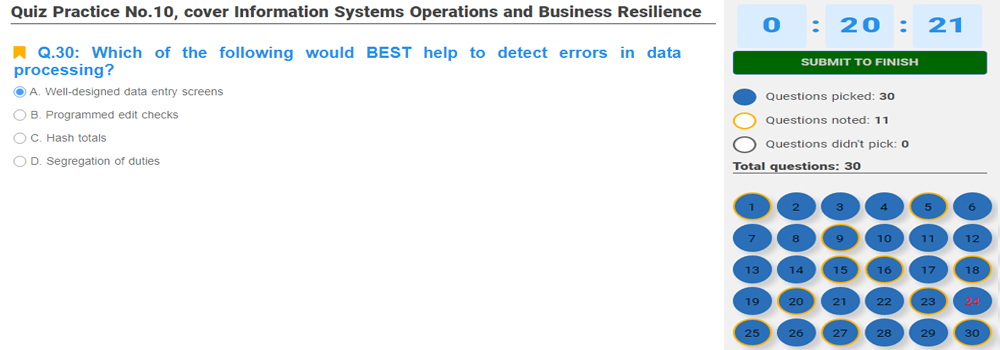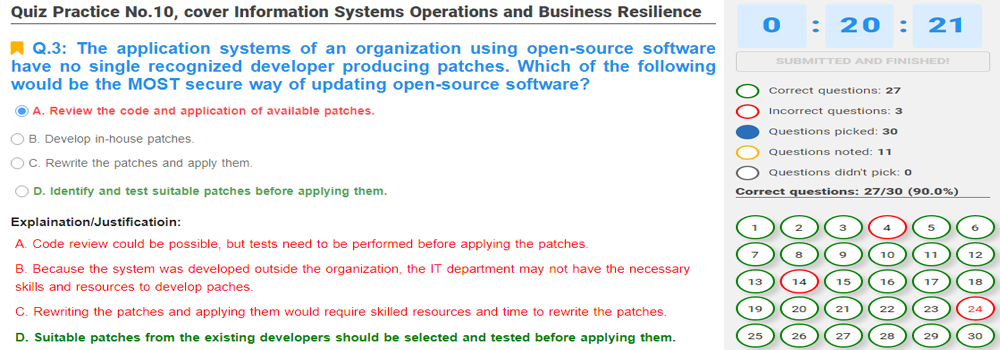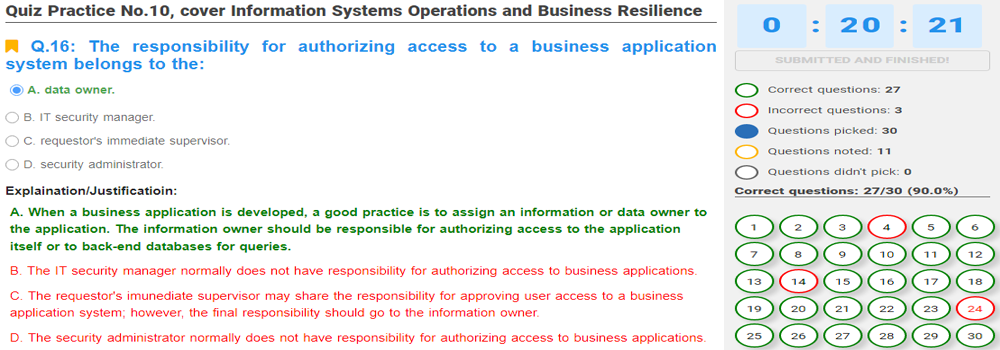[1Z0-083 DUMP UPDATED JUNE, 2024] Oracle Database 19C Administration 2 Cert code: 1Z0-083, Questions of the exam: 68, Minutes of the exam: 120, Correct to pass: 57%.
[1Z0-083 DUMP UPDATED MAY, 2024] Oracle Database 19C Administration 2 Cert code: 1Z0-083, Questions of the exam: 68, Minutes of the exam: 120, Correct to pass: 57%.
[1Z0-083 DUMP UPDATED APRIL, 2024] Oracle Database 19C Administration 2 Cert code: 1Z0-083, Questions of the exam: 68, Minutes of the exam: 120, Correct to pass: 57%.
[1Z0-083 DUMP UPDATED FEBRUARY, 2024] Oracle Database 19C Administration 2 Cert code: 1Z0-083, Questions of the exam: 68, Minutes of the exam: 120, Correct to pass: 57%.
[1Z0-083 DUMP UPDATED JANUARY, 2024] Oracle Database 19C Administration 2 Cert code: 1Z0-083, Questions of the exam: 68, Minutes of the exam: 120, Correct to pass: 57%.
SOME NOTES ABOUT ORACLE DATABASE 19C ADMINISTRATION 2:
Oracle Database 19C Administration 2 [1Z0-083] is an important and mandatory certification on your path to becoming an expert in your field.
To get this certificate, you need to firmly and confidently grasp the content listed below. Then, you need to pass the exam directly on ORACLE's system. This exam has a duration of 120 minutes, with 68 questions. You need to answer correctly at least 57% of the total questions on the exam.
Below are the contents that you need to grasp firmly and confidently before registering to take the exam on ORACLE's system:
1. Creating CDBs and Regular PDBs - Oracle Database: Managing Multitenant Architecture Ed 1
1.1. Configure and create a CDB
1.2. Create a new PDB from the CDB seed
1.3. Explore the structure of PDBs
2. Manage CDBs and PDBs - Oracle Database: Managing Multitenant Architecture Ed 1
2.1. Manage PDB service names and connections
2.2. Manage startup, shutdown and availability of CDBs and PDBs
2.3. Change the different modes and settings of PDBs
2.4. Evaluate the impact of parameter value changes
2.5. Performance management in CDBs and PDBs
2.6. Control CDB and PDB resource usage with the Oracle Resource Manager
3. Backup and Duplicate - Oracle Database: Managing Multitenant Architecture Ed 1
3.1. Perform Backup and Recover CDBs and PDBs
3.2. Duplicate an active PDB
3.3. Duplicate a Database
4. Upgrading and Transporting CDBs and Regular PDBs - Oracle Database: Managing Multitenant Architecture Ed 1
4.1. Upgrade an Oracle Database
4.2. Transport Data
5. Manage Application PDBs - Oracle Database: Managing Multitenant Architecture Ed 1
5.1. Explain the purpose of application root and application seed
5.2. Define and create application PDBs
5.3. Install, upgrade and Patch applications
5.4. Create and administer Application PDBS
5.5. Clone PDBs and Application containers
5.6. Plug and unplug operations with PDBs and application containers
5.7. Comparing Local Undo Mode and Shared Undo Mode
6. Manage Security in Multitenant databases - Oracle Database: Managing Multitenant Architecture Ed 1
6.1. Manage Security in Multitenant databases
6.2. Manage PDB lockdown profiles
6.3. Audit Users in CDBs and PDBs
6.4. Manage other types of policies in application containers
7. Recovery and Flashback - Oracle Database: Managing Multitenant Architecture Ed 1
7.1. Restore and Recovering Databases with RMAN
7.2. Perform CDB and PDB flashback
8. Backup Strategies and Terminology - Oracle Database: Backup and Recovery Workshop
8.1. Perform Full and Incremental Backups and Recoveries
8.2. Compress and Encrypt RMAN Backups
8.3. Use a media manager
8.4. Create multi-section backups of very large files
8.5. Create duplexed backup sets
8.6. Create archival backups
8.7. Backup of recovery files
8.8. Backup non database files
8.9. Back up ASM meta data
9. Restore and Recovery Concepts - Oracle Database: Backup and Recovery Workshop
9.1. Employ the best Oracle Database recovery technology for your failure situation
9.2. Describe and use Recovery technology for Crash, Complete, and Point-in-time recovery
10. Using Flashback Technologies - Oracle Database: Backup and Recovery Workshop
10.1. Configure your Database to support Flashback
10.2. Perform flashback operations
11. Duplicating a Database - Oracle Database: Backup and Recovery Workshop
11.1 Duplicate Databases
12. Configuring and Using RMAN - Oracle Database: Backup and Recovery Workshop
12.1. Configure RMAN and the Database for Recoverability
12.2. Configureand Using an RMAN recovery catalog
13. Diagnosing Failures - Oracle Database: Backup and Recovery Workshop
13.1. Detect and repair database and database block corruption
13.2. Diagnosing Database Issues
14. Performing Recovery - Oracle Database: Backup and Recovery Workshop
14.1. Restore and Recovering Databases with RMAN
14.2. Perform Non RMAN database recovery
15. Transporting Data - Oracle Database: Backup and Recovery Workshop
15.1. Transport Data
16. RMAN Troubleshooting and Tuning - Oracle Database: Backup and Recovery Workshop
16.1. Interpret the RMAN message output
16.2. Diagnose RMAN performance issues
17. Install Grid Infrastructure and Oracle Database - Oracle Database: Deploy, Patch and Upgrade Workshop
17.1. Install Grid Infrastructure for a Standalone server
17.2. Install Oracle Database software
18. Patching Grid Infrastructure and Oracle Database - Oracle Database: Deploy, Patch and Upgrade Workshop
18.1. Patch Grid Infrastructure and Oracle Database
19. Upgrading to Oracle Grid Infrastructure - Oracle Database: Deploy, Patch and Upgrade Workshop
19.1. Upgrade Oracle Grid Infrastructure
20. Oracle Database 18c: New Features - Oracle Database: Deploy, Patch and Upgrade Workshop
20.1. Image and RPM based Database Installation
21. Creating an Oracle Database by using DBCA - Oracle Database: Deploy, Patch and Upgrade Workshop
21.1. Create, Delete and Configure Databases using DBCA
22. Oracle Restart - Oracle Database: Deploy, Patch and Upgrade Workshop
22.1. Configure and use Oracle Restart to manage components
23. Upgrade the Oracle Database - Oracle Database: Deploy, Patch and Upgrade Workshop
23.1. Plan for Upgrading an Oracle Database
23.2. Upgrade an Oracle Database
23.3. Perform Post-Upgrade tasks
24. Install Grid Infrastructure for a Standalone server - Oracle Database: Deploy, Patch and Upgrade Workshop
24.1. Rapid Home Provisioning
25. Using General Overall Database Enhancements - Oracle Database 19c: New Features for Administrators
25.1. Install Oracle Database software
25.2. Create, Delete and Configure Databases using DBCA
25.3. Creating CDBs and Regular PDBs
25.4. Use Miscellaneaous 19c New Features
26. Using Availability Enhancements - Oracle Database 19c: New Features for Administrators
26.1. Use an RMAN recovery catalog
26.2. Use Flashback Database
27. Using Diagnosibility Enhancements - Oracle Database 19c: New Features for Administrators
27.1. Use new Diagnoseability Features
28. Monitoring and Tuning Database Performance - Oracle Database: Administration Workshop
28.1. Managing Memory Components
28.2. Understanding The Automatic Workload Repository (AWR)
28.3. Understanding The Advisory Framework
28.4. Monitoring Wait Events, Sessions, and Services
28.5. Managing Metric Thresholds and Alerts
28.6. Understanding and Using The Performance Tuning Methodology
28.7. Performing Performance Planning
28.8. Understanding The Automatic Database Diagnostic Monitor (ADDM)
29. Tuning SQL Statements - Oracle Database: Administration Workshop
29.1. Understanding The Oracle Optimizer
29.2. Using The SQL Tuning Advisor
29.3. Managing Optimizer Statistics
29.4. Using The SQL Access Advisor
29.5. Understanding The SQL Tuning Process
GOODLUCK TO YOU!!!




